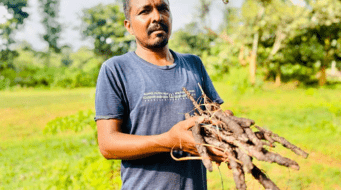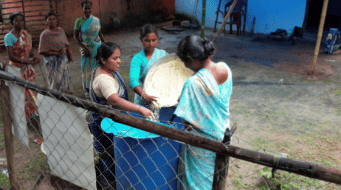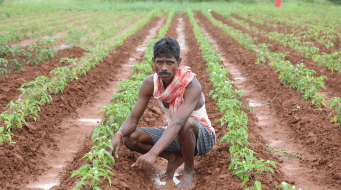– Dr. Saurabh Purohit and Dr. Imran Khan YD

On Monday, December 19th, 2022, a final deal was reached at the Montreal Biodiversity Summit, where nearly 200 nations agreed to conserve 30% of land and ocean by 2030. The main objective of the summit was to finalize global nature targets for 2030 and 2050, which were achieved through the creation of four global goals and 23 global-oriented targets in the Kunming-Montreal Global Biodiversity Framework (GBF). One of these specific targets, Target 6, aims to “eliminate, minimize, reduce, or mitigate the impacts of invasive alien species on biodiversity and ecosystem services by identifying and managing pathways of introduction, preventing the introduction and establishment of priority invasive alien species, reducing the rates of introduction and establishment of other known or potential invasive alien species by at least 50%, by 2030, eradicating or controlling invasive alien species especially in priority sites, such as islands.” (CBD/COP/15/L.25). The inclusion of Invasive Alien Species (IAS) in these targets highlights their importance in the current global scenario.
What are Invasive Alien Species (IAS)?
Invasive alien species (IAS) are non-indigenous plants, animals, and microorganisms that are deliberately or accidentally introduced to new areas beyond their native ranges and have a harmful impact on the economy, environment, and health (Pyšek et al., 2020). Invasion is considered the second leading threat to plant diversity, after habitat destruction (Hobbs & Humphries, 1995). IAS reduce native biodiversity in the region and alter the physicochemical properties of the soil. Additionally, the establishment of one IAS in a new environment can clear the way for other non-native species to invade. Some of the most serious invasive species in India include Alternanthera philoxeroides (Alligator Weed), Senna uniflora (Oneleaf Senna), Chromolaena odorata (Devilweed), Eichhornia crassipes (Water Hyacinth), Lantana camara (Lantana), Parthenium hysterophorus (Congress Grass), and Prosopis juliflora (Mesquite).
Characteristic features of IAS
IAS possess certain characteristic features that contribute to their successful invasion in a particular region. These characteristics include:
- Rapid growth and reproduction
- Aggressive root systems
- High dispersal rates
- High adaptive capacity
- Long flowering and fruiting periods
- High environmental tolerance
Impact of IAS on Riparian Ecotone
Riparian ecotones are highly dynamic systems, which makes them vulnerable to invasion. In addition, by narrowing stream channels and changing soil properties (such as decreased water-holding capacity and increased soil erosion), IAS tend to increase the frequency of floods, which ultimately damages riparian native plant ecosystems and impacts human health. Common IAS of riparian ecotones include Eichhornia crassipes (Water hyacinth), Mikania micrantha (Bitter Vine), Lantana camara, Chromolaena odorata (Devilweed), Ageratum conyzoides (Goat weed), and Monochoria vaginalis (Oval Leaf Pondweed). In this blog, we will discuss Cyperus rotundus L. (Purple Nutsedge), a common weed of agricultural fields that is slowly invading riparian ecotones in the Akole taluka of Ahmednagar district, Maharashtra.
Purple Nutsedge: Introduction and distribution
Cyperus rotundus L. (Purple Nutsedge) is one of the worst IAS due to its wide distribution and impacts. It can grow up to 1 m in height (Fig 1). It is distributed in over 90 tropical and subtropical countries worldwide (Bendixen & Nandihalli, 1987). Several chemical compounds have been isolated from Purple Nutsedge, and some of these chemicals possess medicinal properties and are used globally (Sharma & Gupta, 2007). Pigs eat its tubers, but it makes poor fodder and is reportedly used as a soil stabilizer (Ellison & Barreto, 2004).

Photo Credit: Mr. Krishanmurti
How invasive is the Purple Nutsedge, and what impact does it have on biodiversity?
Nutsedges are among the most difficult IAS to control because of their upright growth habit, rhizomatous root system, and rapid growth. They can rapidly colonize turf, ornamental areas, pastures, cultivated fields, and riparian ecotones. Tubers, basal bulbs, roots, and rhizomes form an intricate underground network that allows the plant to thrive and multiply despite harsh conditions. They reproduce through tubers that store food to help them complete their life cycle the following year. When drought, flooding, or other unfavourable conditions occur, the foliage withers, but viable dormant tubers remain. When conditions are favourable, they establish new plants.
The Purple Nutsedge has become a major problem in subtropical and even arid locations due to its adaptability to high temperatures, sun radiation, and humidity. Although it is a major invasive species in agriculture, it has been observed to extend its habitat into riparian ecotones. Purple Nutsedge’s monoculture dominance outclasses other native riparian species and is well-adapted to wet, sandy soils, threatening riparian areas where disturbance has depleted the native plant community. It also depletes soil nutrients and stores them in the tubers. Under high CO2 conditions, Purple Nutsedge will become more invasive due to an increase in leaf area, root length, and number of tubers (Rogers et al., 2008) (Fig 2).

Photo credit: Dr. Saurabh Purohit
How can we prevent and control Purple Nutsedge?
There are several methods that can be effective in managing this plant:
- Manual control through mechanical removal and tillage,
- Chemical control using herbicides like glyphosate and paraquat, and
- Biological control using the mycoherbicide Dactylaria higginsii.
To be most effective, these methods should be focused on reducing the plant’s tuber reserves and preventing multiplication of new tubers.
Given the invasive capacity of the Purple Nutsedge and the range of damage it can cause, urgent efforts must be taken to mitigate its impact on the ecosystem.
References
- Bendixen, L. E., & Nandihalli, U. B. (1987). Worldwide Distribution of Purple and Yellow Nutsedge (Cyperus rotundus and C. esculentus). Weed Technology, 1(1), 61–65. https://doi.org/DOI: 10.1017/S0890037X00029158
- Ellison, C. A., & Barreto, R. W. (2004). Prospects for the Management of Invasive Alien Weeds Using Co-Evolved Fungal Pathogens: A Latin American Perspective. Biological Invasions, 6(1), 23–45. https://doi.org/10.1023/B:BINV.0000010118.36571.ef
- Hobbs, R. J., & Humphries, S. E. (1995). An Integrated Approach to the Ecology and Management of Plant Invasions. Conservation Biology, 9(4), 761–770. https://doi.org/https://doi.org/10.1046/j.1523-1739.1995.09040761.x
- Pyšek, P., Hulme, P. E., Simberloff, D., Bacher, S., Blackburn, T. M., Carlton, J. T., Dawson, W., Essl, F., Foxcroft, L. C., Genovesi, P., Jeschke, J. M., Kühn, I., Liebhold, A. M., Mandrak, N. E., Meyerson, L. A., Pauchard, A., Pergl, J., Roy, H. E., Seebens, H., … Richardson, D. M. (2020). Scientists’ warning on invasive alien species. Biological Reviews, 95(6), 1511–1534. https://doi.org/https://doi.org/10.1111/brv.12627
- Rogers, H. H., Runion, G. B., Prior, S. A., Price, A. J., Torbert, H. A., & Gjerstad, D. H. (2008). Effects of Elevated Atmospheric CO2 on Invasive Plants: Comparison of Purple and Yellow Nutsedge (Cyperus rotundus L. and C. esculentus L.). Journal of Environmental Quality, 37(2), 395–400. https://doi.org/https://doi.org/10.2134/jeq2007.0155
- Sharma, R., & Gupta, R. (2007). Cyperus rotundus extract inhibits acetylcholinesterase activity from animal and plants as well as inhibits germination and seedling growth in wheat and tomato. Life Science, 80, 24–25.
- Yandoc, C. B., Rosskopf, E. N., Pitelli, R. L. C. M., & Charudattan, R. (2006). Effect of Selected Pesticides on Conidial Germination and Mycelial Growth of Dactylaria higginsii, a Potential Bioherbicide for Purple Nutsedge (Cyperus rotundus). Weed Technology, 20(1), 255–260. https://doi.org/DOI: 10.1614/WT-04-326R1.1
Additional Readings
- Global Invasive Species Database (2023) Species profile: Cyperus rotundus. Downloaded from http://www.iucngisd.org/gisd/species.php?sc=1448 on 03-01-2023.
- Purple Nutsedge (Cyperus rotundus) in Greater Depth. https://eorganic.org/node/5134
- Kunming-Montreal Global biodiversity framework draft report (CBD/COP/15/L.25). https://www.cbd.int/doc/c/e6d3/cd1d/daf663719a03902a9b116c34/cop-15-l-25-en.pdf
- Riparian Ecotones and why conserving them is absolutely essential





